Electric distribution utilities frequently ask the question, “Can we afford to automate?” Given the potential cost, the question is certainly reasonable. But in the era of deregulation and everincreasing regulatory pressure, the question really ought to be, “Can we afford not to?” The truth is that if you don’t spend the money to automate in the near future, your competitor probably will. And from that point on, instead of competing head-on, you will be playing catch-up in a marketplace geared toward competition. In that light, it’s best to consider distribution automation as an investment rather than an expense.
The cost-saving advantages of automation are well documented – systems operate more efficiently with fewer outages, assets are better utilized and maintained, and personnel safety improves. These add up to reduced costs and greater reliability, which ultimately wins customers and pleases regulators.
But there is another equally important, yet less tangible, pay-off from automation — information. It’s the commodity of the 21st century and it’s what will provide the competitive edge in the utility industry from now on. Implemented correctly, automation puts information about the distribution system — and your customers — onto the desktops of every department in the enterprise for analysis.
Suddenly, the guys in marketing are brainstorming with the engineers about how to create and sell customized services. When accurate information is available quickly to personnel at all levels, everyone starts making better decisions, and that benefits the entire organization.
Better yet, automation positions a utility to serve real-time information directly to the customer. Several savvy distribution companies already are publishing detailed system reliability information and up-to-date customer usage data on their web sites. Voltages, currents, megawatts and outage history are all right there on the Internet for existing and potential customers to see.
For consumers who have grown accustomed to immediate online access to bank balances and credit card statements, such web-based information is more than a nice feature. It’s a benefit that can attract and retain them.
As is true with many high-tech innovations, utility automation requires proper implementation to deliver the advertised benefits. In the distribution network, a correctly implemented automation project does not stand alone. Automation devices must be integrated into the architecture of the distribution system itself, most effectively at the substation level, drawing data from every piece of equipment and subsystem.
Secondly, integration and automation require communication links between the computerized devices and the rest of the utility enterprise. There are at least three distinct paths that can be exploited for data from the substation to travel within a distribution utility. This is how automation data is shared for simultaneous access and analysis throughout the company.
Ensuring that automation and integration proceed hand-in-hand guarantees a quick return on investment. Making it happen requires a strategic plan and a commitment to carry out that plan as it was designed. And in all cases, communications infrastructure must be sufficient to successfully support the automation.
What is Distribution Automation?
In a distribution utility there are three areas where automation can be implemented – at the customer location, on the feeders and in the substation. Each has pros and cons, but substations are the typical focal points because they are the greatest source of information.
Every utility has varying needs for automation depending on the age of its infrastructure, service area demographics and degree of existing automation. For this reason, all three sources of distribution automation should be considered in developing a strategic implementation plan. Here is a quick overview of the benefits, and possible pitfalls, of each:
Customer Automation – Automatic Meter Reading (AMR) technology and services associated with it, such as automatic connect/reconnect, are gaining in popularity. AMR periodically records meter readings and relays this information back to a utility office. Installed at the customer location, AMR replaces a human meter reader. It is especially effective in high-crime neighborhoods where utility personnel may find themselves in danger.
The primary expense involved in AMR is not the meter itself. Rather it is the communications link, usually a wireline (telephone) or wireless connection, that transmits to the utility office from each individual user location. For large commercial and industrial customers who use a lot of power, this expense is quickly repaid. But for tens of thousands of residential customers, the cost is difficult to justify for simple meter reading.
A related service that can pay for itself is automatic connect/reconnect. In cities with rapid population turnover, several utilities have found it is cost-effective to remotely disconnect service every time a customer moves rather than send a crew to do it manually. But this may be the exception in regards to AMR pay-out.
However, just because AMR might not be cost-effective or improve utility personnel safety, it should not be discounted from an automation plan. The reason is that AMR requires the utility to make a live communications link with each customer, and that link may serve as the conduit through which other valuable services can be offered.
Once two-way communication has been established to a residential user, the utility has opened the door to offering such lucrative services as remotely monitored home security, high-speed Internet access and cable television. But the key to providing these services is including them in the strategic distribution automation plan at the outset so the appropriate telecommunications infrastructure can be installed.
Feeders – Automating feeders typically entails installation of sectionalizing devices, or switches, along the feeder. When there is a problem with the feeder, data will be fed back to the substation or control center for analysis. Once the problem has been identified, a technician can remotely activate the switch to isolate the segment causing the trouble and reroute service to sections on either side of the problem, or this process may be done automatically.
The financial challenge of feeder automation is similar to that of AMR – feeders are numerous and are spread over large geographic areas, making installation and maintenance of two-way communication an expensive proposition. As a result, feeder automation is often limited to the 10 or 15 worst performing feeders.
By concentrating on problematic feeders, utilities spend less money and can guarantee their automation investment will pay off in reduced duration and frequency of outages. This sort of targeted feeder automation is likely to remain standard procedure in distribution automation projects.
A typical initial step in implementing feeder automation is to install a tie switch on a feeder between two substations. Often referred to as using half switches, the method provides the capability to shift feeder load segments from one substation to another.
Substation – Integration and automation typically focus here because the substation is where all of that valuable operations and customer information resides. Whether they know it or not, most utilities already engage in the first level of substation automation – intelligent electronic device (IED) implementation.
Since the late 1980s, advancements in microprocessor technology have eliminated single function electromechanical equipment in favor of multifunction IEDs. These single-function electromechanical devices have given way to multi-function electronic devices with built-in two-way communications capabilities.
Years ago, separate electromechanical relays were required for overcurrent and undervoltage protection. Today, one microprocessor-based device does that and more. They not only protect the power system, but they can also perform calculations of energy in a circuit breaker and store historical data in their memory. Microprocessor-based relays can identify when a fault occurred and the series of events that resulted from it.
That’s incredibly valuable information. Too bad so few utilities use it. This is because most have not tapped the two-way communication capabilities in these devices to access and integrate the data they hold into the information flow of the enterprise. The average utility is realizing about 10 percent of their investment in a $5,000 microprocessor-based relay.
A substation integration mistake made most commonly is not creating and following a strategic substation integration and automation plan. Too often an engineer gets excited about a vendor’s substation integration and automation architecture and has it installed. Next, a different vendor offers a substation integration and automation architecture with different features, and that one is installed too. The next thing a utility knows, it has 12 substations operating with substation architectures from five different vendors. No utility has the resources to use and support such a variety of equipment and architectures.
Integrating the Substation
The key to capitalizing on the capabilities of automated devices is integrating the devices and linking them to the utility enterprise along three data paths.
Substation integration systems are a combination of software and hardware to meet the needs of an individual utility. These integration systems are offered as products by companies well known to the industry – Tasnet in Clearwater, Florida; Hathaway in Hunt Valley, Maryland; GE in Calgary, Alberta, Canada; ABB in Allentown, Pennsylvania; and Siemens in Raleigh, North Carolina. Each integration architecture is different, but all exploit the three data paths into and out of the substations to take advantage of IED installations.
Often referred to as the operational data path, the first is between the substation integration and automation system and the SCADA system. The SCADA can be programmed to scan automated devices in the substation every few seconds to retrieve instantaneous values on voltage, current and other data. The operational data path is established for a continuous feed of data.
Several factors must be considered in leveraging this path. First, substation integration and automation systems must have the capability to interface with older SCADA systems and their proprietary protocols. Secondly, the bandwidth of the communications infrastructure chosen for this path must support requirements of the SCADA and the substation integration and automation system.
The second data path is more of a challenge. It involves gaining access to the non-operational information in the IEDs. Non-operational data includes fault event logs, harmonic information, and power quality information such as voltage sags and swells, information that needs to be transferred to a corporate data warehouse where many users can retrieve it into their desktop applications for analysis.
Each different device in the substation typically operates with a different protocol for this non-operational data path. The data on this path is on-demand, non-periodic, which means protocol issues are more complicated. Usually the demand is for a large file or a burst of data, necessitating a bandwidth of at least 56 kbps on a frame relay or fiber optic network.
Non-operational data is transmitted back to the corporate data warehouse. This warehouse is typically a series of centralized servers for redundancy that incorporate all business and operations information from around the utility for enterprise-wide access. Because not all utilities currently have such a data warehouse, installation of one is often included in an automation project.
The third path is remote access, which allows a user at a location outside the substation to access the IEDs. With proper security and access privileges, the user might review device settings or actually change parameters, as well as download non-operational IED data for analysis.
Often called pass-through or loop-through, this communication path is typically a dial-up phone line or dedicated fiber optic connection. The user dials into a secure modem, which then calls the user back if his or her phone number is approved. The user then dials a code to specify which device the communications link should be established with. Data flow between the caller and the device is two-way.
By integrating IEDs into the architecture of the substation and linking the flow of data from the substation to the enterprise, the utility truly realizes the potential in the investment it has made in the IEDs.
Creating a Strategic Plan
Successful integration and automation projects require a strategic plan, or a blue print for how and when various IEDs and integration architectures will be installed. The first step is to examine the integration and automation functions available and perform a cost-benefit analysis to determine if a specific utility will benefit from the implementation of that function. Not all will.
Matching the needs of the utility with available technology is critical. As odd as it may sound, sometimes automation technology is not yet available to accomplish what the utility needs. Off-the-shelf products are always preferred over customized ones simply because of the cost involved. Customization may completely destroy a return-on-investment estimate.
The next step is developing a phased-in approach for implementation of integration and automation. Few utilities can afford to pay for a large-scale implementation in one year, so the project may be spread over five or more. But it is critical to stick with the original plan and determine how implementation of integration and automation should proceed to ensure the utility begins experiencing benefits immediately.
Keep in mind that communications is the enabling technology of integration and automation. This means that existing communications capabilities must be compared with what will be needed for the planned project and for future automation.
As mentioned at the outset, most utilities can’t afford not to integrate and automate. With a simple substation pilot costing around $50,000 to $100,000 per substation, the benefits typically are far greater than the costs, especially since the IEDs are already installed in the substation.
Measuring Success
In terms of substation integration, look for positive operational changes to see if benefits of specific functions are being realized. For example, in the successfully integrated substation there will be smaller control panels, reduced wiring and elimination of many conventional displays as computers replace mechanical devices. The result is that utilities begin building much smaller substations at significantly less cost. With respect to cost/- benefits, the advantages of these changes quickly impact the bottom line.
Even enterprise-wide integration and automation projects pay off in one to three years, but utilities and their stockholders want to see quantitative results immediately. The best measurements to use in assessing the success of any size distribution automation project are the industry standard indices of reliability – System Average Interruption Frequency Index (SAIFI), Momentary Average Interruption Frequency Index (MAIFI) and System Average Interruption Duration Index (SAIDI).
These are the same indices regulatory agencies use to measure utility performance, and as deregulation progresses the typical residential customer is likely to become savvy in their meaning too. In the near future, we are likely to see these numbers like report cards on publicly available web site. And you can be sure the utilities with the scores that show steady improvement are the ones that have invested in automation and integration.
The cost-saving advantages of automation are well documented – systems operate more efficiently with fewer outages, assets are better utilized and maintained, and personnel safety improves. These add up to reduced costs and greater reliability, which ultimately wins customers and pleases regulators.
But there is another equally important, yet less tangible, pay-off from automation — information. It’s the commodity of the 21st century and it’s what will provide the competitive edge in the utility industry from now on. Implemented correctly, automation puts information about the distribution system — and your customers — onto the desktops of every department in the enterprise for analysis.
Suddenly, the guys in marketing are brainstorming with the engineers about how to create and sell customized services. When accurate information is available quickly to personnel at all levels, everyone starts making better decisions, and that benefits the entire organization.
Better yet, automation positions a utility to serve real-time information directly to the customer. Several savvy distribution companies already are publishing detailed system reliability information and up-to-date customer usage data on their web sites. Voltages, currents, megawatts and outage history are all right there on the Internet for existing and potential customers to see.
For consumers who have grown accustomed to immediate online access to bank balances and credit card statements, such web-based information is more than a nice feature. It’s a benefit that can attract and retain them.
As is true with many high-tech innovations, utility automation requires proper implementation to deliver the advertised benefits. In the distribution network, a correctly implemented automation project does not stand alone. Automation devices must be integrated into the architecture of the distribution system itself, most effectively at the substation level, drawing data from every piece of equipment and subsystem.
Secondly, integration and automation require communication links between the computerized devices and the rest of the utility enterprise. There are at least three distinct paths that can be exploited for data from the substation to travel within a distribution utility. This is how automation data is shared for simultaneous access and analysis throughout the company.
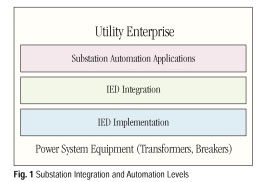
Ensuring that automation and integration proceed hand-in-hand guarantees a quick return on investment. Making it happen requires a strategic plan and a commitment to carry out that plan as it was designed. And in all cases, communications infrastructure must be sufficient to successfully support the automation.
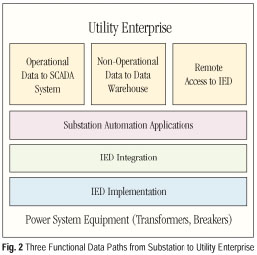
What is Distribution Automation?
In a distribution utility there are three areas where automation can be implemented – at the customer location, on the feeders and in the substation. Each has pros and cons, but substations are the typical focal points because they are the greatest source of information.
Every utility has varying needs for automation depending on the age of its infrastructure, service area demographics and degree of existing automation. For this reason, all three sources of distribution automation should be considered in developing a strategic implementation plan. Here is a quick overview of the benefits, and possible pitfalls, of each:
Customer Automation – Automatic Meter Reading (AMR) technology and services associated with it, such as automatic connect/reconnect, are gaining in popularity. AMR periodically records meter readings and relays this information back to a utility office. Installed at the customer location, AMR replaces a human meter reader. It is especially effective in high-crime neighborhoods where utility personnel may find themselves in danger.
The primary expense involved in AMR is not the meter itself. Rather it is the communications link, usually a wireline (telephone) or wireless connection, that transmits to the utility office from each individual user location. For large commercial and industrial customers who use a lot of power, this expense is quickly repaid. But for tens of thousands of residential customers, the cost is difficult to justify for simple meter reading.
A related service that can pay for itself is automatic connect/reconnect. In cities with rapid population turnover, several utilities have found it is cost-effective to remotely disconnect service every time a customer moves rather than send a crew to do it manually. But this may be the exception in regards to AMR pay-out.
However, just because AMR might not be cost-effective or improve utility personnel safety, it should not be discounted from an automation plan. The reason is that AMR requires the utility to make a live communications link with each customer, and that link may serve as the conduit through which other valuable services can be offered.
Once two-way communication has been established to a residential user, the utility has opened the door to offering such lucrative services as remotely monitored home security, high-speed Internet access and cable television. But the key to providing these services is including them in the strategic distribution automation plan at the outset so the appropriate telecommunications infrastructure can be installed.
Feeders – Automating feeders typically entails installation of sectionalizing devices, or switches, along the feeder. When there is a problem with the feeder, data will be fed back to the substation or control center for analysis. Once the problem has been identified, a technician can remotely activate the switch to isolate the segment causing the trouble and reroute service to sections on either side of the problem, or this process may be done automatically.
The financial challenge of feeder automation is similar to that of AMR – feeders are numerous and are spread over large geographic areas, making installation and maintenance of two-way communication an expensive proposition. As a result, feeder automation is often limited to the 10 or 15 worst performing feeders.
By concentrating on problematic feeders, utilities spend less money and can guarantee their automation investment will pay off in reduced duration and frequency of outages. This sort of targeted feeder automation is likely to remain standard procedure in distribution automation projects.
A typical initial step in implementing feeder automation is to install a tie switch on a feeder between two substations. Often referred to as using half switches, the method provides the capability to shift feeder load segments from one substation to another.
Substation – Integration and automation typically focus here because the substation is where all of that valuable operations and customer information resides. Whether they know it or not, most utilities already engage in the first level of substation automation – intelligent electronic device (IED) implementation.
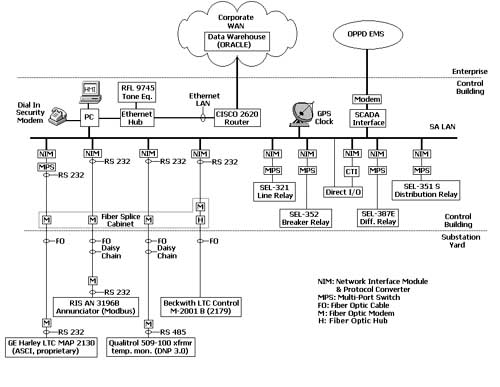
Since the late 1980s, advancements in microprocessor technology have eliminated single function electromechanical equipment in favor of multifunction IEDs. These single-function electromechanical devices have given way to multi-function electronic devices with built-in two-way communications capabilities.
Years ago, separate electromechanical relays were required for overcurrent and undervoltage protection. Today, one microprocessor-based device does that and more. They not only protect the power system, but they can also perform calculations of energy in a circuit breaker and store historical data in their memory. Microprocessor-based relays can identify when a fault occurred and the series of events that resulted from it.
That’s incredibly valuable information. Too bad so few utilities use it. This is because most have not tapped the two-way communication capabilities in these devices to access and integrate the data they hold into the information flow of the enterprise. The average utility is realizing about 10 percent of their investment in a $5,000 microprocessor-based relay.
A substation integration mistake made most commonly is not creating and following a strategic substation integration and automation plan. Too often an engineer gets excited about a vendor’s substation integration and automation architecture and has it installed. Next, a different vendor offers a substation integration and automation architecture with different features, and that one is installed too. The next thing a utility knows, it has 12 substations operating with substation architectures from five different vendors. No utility has the resources to use and support such a variety of equipment and architectures.
Integrating the Substation
The key to capitalizing on the capabilities of automated devices is integrating the devices and linking them to the utility enterprise along three data paths.
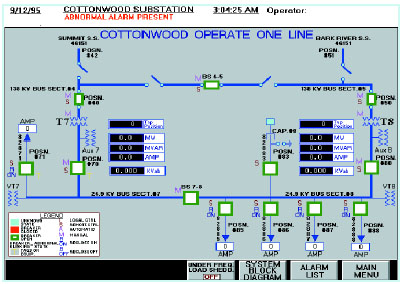
Substation integration systems are a combination of software and hardware to meet the needs of an individual utility. These integration systems are offered as products by companies well known to the industry – Tasnet in Clearwater, Florida; Hathaway in Hunt Valley, Maryland; GE in Calgary, Alberta, Canada; ABB in Allentown, Pennsylvania; and Siemens in Raleigh, North Carolina. Each integration architecture is different, but all exploit the three data paths into and out of the substations to take advantage of IED installations.
Often referred to as the operational data path, the first is between the substation integration and automation system and the SCADA system. The SCADA can be programmed to scan automated devices in the substation every few seconds to retrieve instantaneous values on voltage, current and other data. The operational data path is established for a continuous feed of data.
Several factors must be considered in leveraging this path. First, substation integration and automation systems must have the capability to interface with older SCADA systems and their proprietary protocols. Secondly, the bandwidth of the communications infrastructure chosen for this path must support requirements of the SCADA and the substation integration and automation system.
The second data path is more of a challenge. It involves gaining access to the non-operational information in the IEDs. Non-operational data includes fault event logs, harmonic information, and power quality information such as voltage sags and swells, information that needs to be transferred to a corporate data warehouse where many users can retrieve it into their desktop applications for analysis.
Each different device in the substation typically operates with a different protocol for this non-operational data path. The data on this path is on-demand, non-periodic, which means protocol issues are more complicated. Usually the demand is for a large file or a burst of data, necessitating a bandwidth of at least 56 kbps on a frame relay or fiber optic network.
Non-operational data is transmitted back to the corporate data warehouse. This warehouse is typically a series of centralized servers for redundancy that incorporate all business and operations information from around the utility for enterprise-wide access. Because not all utilities currently have such a data warehouse, installation of one is often included in an automation project.
The third path is remote access, which allows a user at a location outside the substation to access the IEDs. With proper security and access privileges, the user might review device settings or actually change parameters, as well as download non-operational IED data for analysis.
Often called pass-through or loop-through, this communication path is typically a dial-up phone line or dedicated fiber optic connection. The user dials into a secure modem, which then calls the user back if his or her phone number is approved. The user then dials a code to specify which device the communications link should be established with. Data flow between the caller and the device is two-way.
By integrating IEDs into the architecture of the substation and linking the flow of data from the substation to the enterprise, the utility truly realizes the potential in the investment it has made in the IEDs.
Creating a Strategic Plan
Successful integration and automation projects require a strategic plan, or a blue print for how and when various IEDs and integration architectures will be installed. The first step is to examine the integration and automation functions available and perform a cost-benefit analysis to determine if a specific utility will benefit from the implementation of that function. Not all will.
Matching the needs of the utility with available technology is critical. As odd as it may sound, sometimes automation technology is not yet available to accomplish what the utility needs. Off-the-shelf products are always preferred over customized ones simply because of the cost involved. Customization may completely destroy a return-on-investment estimate.
The next step is developing a phased-in approach for implementation of integration and automation. Few utilities can afford to pay for a large-scale implementation in one year, so the project may be spread over five or more. But it is critical to stick with the original plan and determine how implementation of integration and automation should proceed to ensure the utility begins experiencing benefits immediately.
Keep in mind that communications is the enabling technology of integration and automation. This means that existing communications capabilities must be compared with what will be needed for the planned project and for future automation.
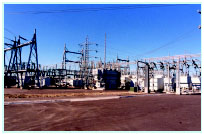
As mentioned at the outset, most utilities can’t afford not to integrate and automate. With a simple substation pilot costing around $50,000 to $100,000 per substation, the benefits typically are far greater than the costs, especially since the IEDs are already installed in the substation.
Measuring Success
In terms of substation integration, look for positive operational changes to see if benefits of specific functions are being realized. For example, in the successfully integrated substation there will be smaller control panels, reduced wiring and elimination of many conventional displays as computers replace mechanical devices. The result is that utilities begin building much smaller substations at significantly less cost. With respect to cost/- benefits, the advantages of these changes quickly impact the bottom line.

Even enterprise-wide integration and automation projects pay off in one to three years, but utilities and their stockholders want to see quantitative results immediately. The best measurements to use in assessing the success of any size distribution automation project are the industry standard indices of reliability – System Average Interruption Frequency Index (SAIFI), Momentary Average Interruption Frequency Index (MAIFI) and System Average Interruption Duration Index (SAIDI).
These are the same indices regulatory agencies use to measure utility performance, and as deregulation progresses the typical residential customer is likely to become savvy in their meaning too. In the near future, we are likely to see these numbers like report cards on publicly available web site. And you can be sure the utilities with the scores that show steady improvement are the ones that have invested in automation and integration.






